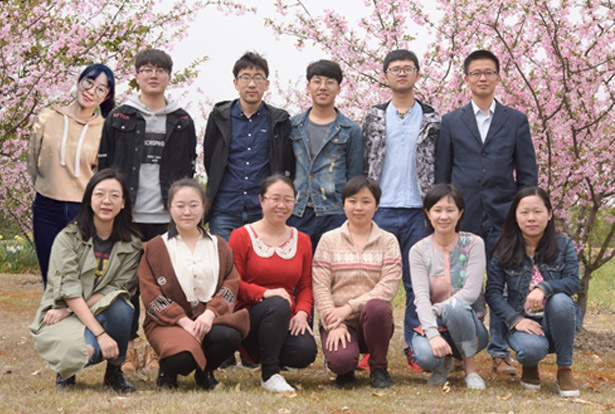TEAMS
Ongoing Research:
1.Fern phylogenybasing on transcriptome analyses
2. Taxonomy of fern genus Hypolepis (Dennstaedtiaceae)
3.Evolution of life strategies in ferns based on functional traits
4.Coevolution between ferns and insects using comparative phylogeographical method
Recent Progress:
(1) Phylogenomic analysis resolves a backbone phylogeny in ferns
Ferns are the sister group of seed plants, of which the major lineages remain controversial. With the aim to obtain a robust fern phylogeny, we carried out a large scale phylogenomic analysis using high-quality transcriptome sequence, which covered 69 fern species from 38 families and 11 orders. Our result confirmed that Equisetales issister to the rest of ferns, and Dennstaedtiaceae is sister to eupolypods. Moreover, our result strongly supported somerelationships different from the current view of fern phylogeny, including that Marattiaceae may be sister to themonophyletic clade of Psilotaceae and Ophioglossaceae; that Gleicheniaceae and Hymenophyllaceae form a monophyleticclade sister to Dipteridaceae; and that Aspleniaceae is sister to the rest of the groups in eupolypods II. This backbone phylogeny in ferns sets a foundation for further studies in biology and evolution inferns, and therefore in plants.

(2) Re-establishment of species from synonymies based on DNA barcoding and phylogenetic analysis using Diplopterygium simulans (Gleicheniaceae) as an example
Synonymy treatmentshave based mainly on morphological traits, whichcausemany problems in species delimitation and in the biodiversity catalogue. For example,Diplopterygium simulans, which belongs to the Gleicheniaceae family, has been consideredto be synonymous with D. glaucum or D. giganteum based mainly on the morphologyof its pinna rachis and blade. In the absence of molecular evidence, these revisions remaindoubtful. DNA barcoding, which is considered to be a powerful method for species-levelidentification, was employed to assess the genetic distance among 9 members of the Diplopterygium genus. The results indicate that D. simulans is an independent speciesrather than a synonymy of D. glaucum or D. giganteum. Moreover, phylogenetic analysisuncovered the sisterhood of D. simulans and D. cantonense, which is supported by theirgeographical distributions and morphological traits. Incorrect synonymy treatment is prevalentin the characterization of biological diversity, and our study proposes a convenient andeffective method for validating synonym treatments and discovering cryptic species.

3 ) Living ferns Collection and Conservation
Diplazium yinchanianum, a new species of Athyriaceae from the Shiwandashan Mountain in Guangxi, China, is describedand illustrated. This species is morphologically most similar to D. yaoshanense with both having a long creeping rhizomeand 1-pinnate laminae with an abruptly reduced apex, but differs from the latter by having oblong laminae with an apicalpinna. Molecular phylogenetic analysis based on the plastid matK, rbcL, and trnL-F sequences indicated that the two speciesare distantly related.

1. Hui Shen#, Dongmei Jin#, Jiang-Ping Shu, Xi-Le Zhou, Ming Lei, Ran Wei, Hui Shang, Hong-Jin Wei, Rui Zhang, Li Liu ,Yu-Feng Gu, Xian-Chun Zhang, Yue-Hong Yan*. 2018. Large scale phylogenomic analysis resolves a backbone phylogeny in ferns. GigaScience 7:1-11.
2. Zi-Yue Liu, Hong-Jin Wei, Hui Shang, Ran Wei, Ying Wang, Bao-Dong Liu, Yue-Hong Yan*. 2018. Diplazium yinchanianum (Athyriaceae): A new fern from the border between China and Vietnam. Phytotaxa 343(2):139-148.
3. Jiang-Ping Shu, Hui Shang, Dongmei Jin, Hong-jin Wei, Xi-Lei Zhou,Hong-Mei Liu, Yu-Feng Gu, Ying Wang, Fa-Guo Wang, Hui Shen, Rui Zhang, Bayu Adjie, Yue-Hong Yan*. 2017. Re-establishment of species from synonymies based on DNA barcoding and phylogenetic analysis using Diplopterygium simulans (Gleicheniaceae) as an example. PLoS ONE 12(3): e0164604.
4. Yuehong Yan*, Ming Kang, Yongpeng Ma, Renchao Zhou. 2017. Natural hybridization: a nightmare or a delight to biodiversity? Biodiversity Science 25 (6): 561–564.
5. Jiangping Shu, Li Liu, Hui Shen, Xiling Dai, Quanxi Wang, Yuehong Yan*2017. The complex reticulate evolutionary relationships of early terrestrial plants as revealed by phylogenomics analysis. Biodiversity Science 25(6): 675-682.
6. Hui Shang, Yuehong Yan*. 2017. Natural hybridization and biodiversity conservation. Biodiversity Science 25 (6): 683–688.
7. Xile Zhou, Dongmei Jin, Yicheng Liu, Hui Shang, Yuehong Yan*. 2017. Sporangia Morphology of Ferns I. Lindsaeaceae. Chinese Bulletin of Botany 52 (3): 322–330.
8. Hui Shang, Ying Wang, Xiao-Feng Zhu, Guo-Hua Zhao, Fan-Hong Wang, Jin-Mei Lu, Yue-Hong Yan. 2016. Likely allopatric origins of Adiantum × meishanianum (Pteridaceae) through allopatric and multiple hybridization. Journal of Systematics and Evolution. 54(5):528-534.
9. Dongmei Jin#, Yong Huang#, Xi-Le Zhou, Bin Chen, Jinshuang Ma, Yue-Hong Yan*. 2015. High risk of plant invasion in the understory of eucalypt plantations in South China. Scientific Reports. 5:18492.
10. Hui Shang, Qi-Xia Ma, Yue-Hong Yan*. 2015. Dryopteris shiakeana (Dryopteridaceae): A new fern from Danxiashan in Guangdong, China. Phytotaxa. 218(2):156-162.
11. Hui Shang, Ying Wang, Yue-Hong Yan*. 2015. Development and characterization of microsatellite loci in a pantropical fern Hypolepis punctata (Dennstaedtiaceae). Applications in Plant Sciences. 3(9):1-3.
12. Hui Shen, Xiangbin Zhong, Fangfang Zhao, Yanmei Wang, Bingxiao Yan, Qun Li, Genyun Chen, Bizeng Mao, Jianjun Wang, Yangsheng Li, Guoying Xiao, Yuke He, Han Xiao, Jianming Li & Zuhua He*. 2015. Overexpression of receptor-like kinase ERECTA improves thermotolerance in rice and tomato. Nature Biotechnology. 33:996–1003.
13. Ying Wang, Hui Shang, Xi-Le Zhou, Guo-Hua Zhao, Xi-Ling Dai, and Yue-Hong Yan*. 2015. Adiantum × ailaoshanense (Pteridaceae), a new natural hybrid from Yunnan, China. Phytotaxa. 236(3):266–272.
 | Principal investigator (PI) |
Education Background
Ph. D: 2002-2005, Plant Ecology, South China Botanical Garden, Chinese Academy of Sciences, China
Master: 2000-2002, Plant Taxonomy, South China Botanical Garden, Chinese Academy of Sciences, China
Bachelor: 1995-1999, Biology, Xiangtan Normal University, Hunan, China
Experience
Since 2015, Professor, Shanghai Chenshan Plant Science Research Center, the Chinese Academy of Sciences / Shanghai Chenshan Botanical Garden,Songjiang, Shanghai, China
2011-2015, Associate Professor, Shanghai Chenshan Plant Science Research Center, the Chinese Academy of Sciences / Shanghai Chenshan Botanical Garden,Songjiang, Shanghai, China
2005-2011, Associate Professor, Hunan University of Science and Technology, Xiangtan, Hunan, China
2009-2010, Visiting Scholar, Kadoorie Farm and Botanic Garden, Tai Po, New Territories, Hong Kong, China
2007-2009, Post Doctor, Institute of Botany, the Chinese Academy of Sciences
 | Jin Dongmei Ph.D., Research Assistant Tel: 021-37792288-919 E-mail: jindongmei@csnbgsh.cn |  | Shen Hui Ph.D., Research Assistant Tel: 021-37792288-919 E-mail: shenhui@sibs.ac.cn |
 | Shang Hui M.S., Research Assistant Tel: 021-37792288-919 E-mail: sh007-008@163.com |  | Zhang Rui |
 | Wei Hongjin |
| |
 | Liu Li(2015) Study interest: Genomics |  | Luo Junjie(2016) |
 | Zhang Jiao(2016) |  | Wei Hongyu (2016) Study interest: Adaptation |
 | Morigengaowa (2016) Study interest: Reproduction and taxonomy |  | Wang Hao (2017) Study interest: Whole genome duplications |
